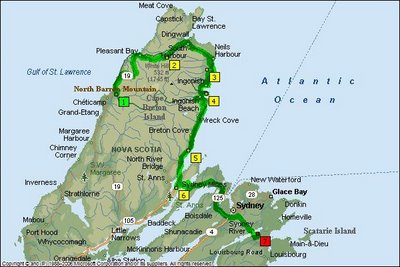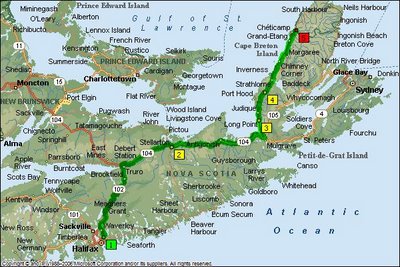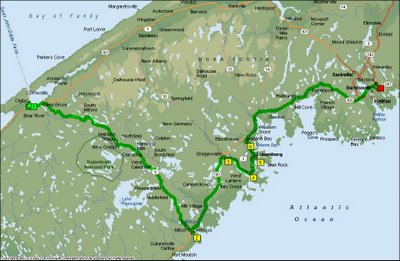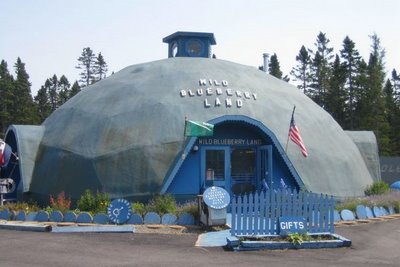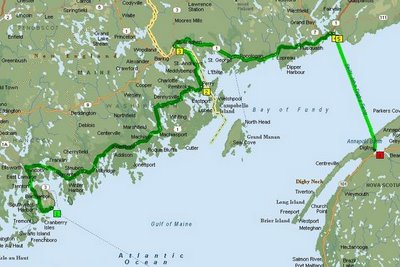Ned and Joe at Fortress of Louisbourg
Monday started off wet. It rained all night and into the morning. A good hard rain when you are in a tent is not fun. After about the fifth hour I started to notice that the tent was leaking in a few spots. Fortunately the rain stopped around 7:30 am and the tent leaked very little, nothing a few socks were not able to soak up.
The reason we were in the Southeast corner of Nova Scotia was to visit the Fortress of Louisbourg. The fortress was founded by the French in 1719 to protect their lucrative cod fisheries. Unfortunately they were competing with the British over this and the control over North America. In 1745 the British lay seige and captured the town. It was given back to the French three years later by treaty. In 1758 the British again captured the town and this time razed it.
In 1961 the Canadian government began a reconstruction of the town and fortifications. When you enter the town you are transported back to 1744 a year before the first siege. There are re-enactors throughout the village and fortress taking on the different roles of bakers, soldiers, cooks, fisherman etc.
When we tried to enter the gate the soldier on guard demanded to know where we from and what our business was. He quite put off to find that we were "British" and possible spies. Ned vouched for us we were allowed to enter.
Because of the wet weather I thought our visit was a bit more realistic. The fog was thick and nothing could be seen beyond the town. The ground was muddy and people had mud on them. The downside was being cold and wet. We still spent about five hours there looking in the different buildings, watching the blacksmiths, talking to the villagers, watching a cannon being fired and having a meal at one of the taverns.
The Approach to the Fortress of Loiusbourg
The Children at Dance and Song
The Waterfront Street of Louisbourg
The Frederick Gate
Joe Watches for the British
Overseeing the Troops
The Fortress Wall in the Fog
Ned and Joe Visiting
Conversing in the Kitchen
Saying au revoir to the fortress we started for Prince Edward Island. On the way we made a stop in Baddeck, NS, to visit the Alexander Graham Bell National Historic Site. Bell decided to build a vacation home in Baddeck in 1885 after visiting because in his words, "I have traveled the globe. I have seen the Canadian and American Rockies, the Andes and the Alps and the highlands of Scotland, but for simple beauty, Cape Breton outrivals them all." The museum has exhibits on Bell´s wide ranging interests and inventions, much of it undertaken at Baddeck.
From Baddeck we drove to Caribou to catch the ferry to Prince Edward Island. Originally I had not planned to take the ferry to PEI but I found out that you have to pay one way, to get off the island. We managed to catch the 7:30 pm ferry and soon found ourselves in Cavendish.
We were going to stay at one of the campgrounds in Prince Edward Island National Park reccomended by our guide book. After driving around for a while I could not find it and after stopping to ask for directions found out that it was shutdown three to four years prior. So much for our up to date guide books, I should have called ahead. We went to one of the other campgrounds and ending up sleeping in the car. The facilities were in such bad shape that I decided in the morning we would try and get a spot at the Cavendish campground.
The Ferry to Prince Edward Island
The Woods Island Light on Prince Edward Island
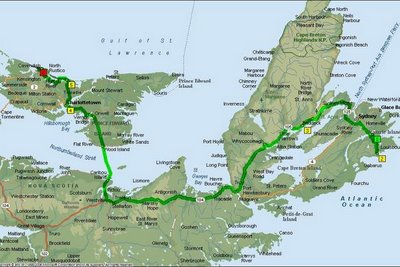
Louisbourg, NS to Cavendish, PEI, 310 miles 6 hrs 25 min

